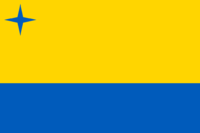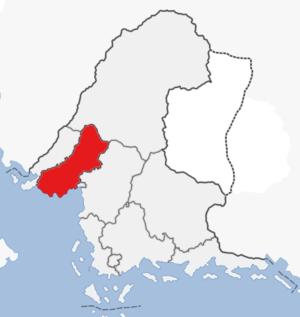Western Amarra
| Thanatos – Western Amarra – Western Sanilla | |
| PЬумәқe AмapЬa Aтe Province of Western Amarra | |
| Capital | Sëwulat |
| Largest cities | Tripoli di Laguna, Aruang, Ranti Lunti, Ranti Lloperat, Boomwatch |
|
| |
| Population | |
|
9,207,083 (1680) |
|
79.02 per km2 |
|
7 of 9 |
| Area | 116,513 km2 |
|
5 of 9 |
|
| |
| Government | |
|
Executive Council (11) |
|
Legislative Assembly (269) |
|
| |
| National representation | |
| 63 MLs | |
|
| |
| Language(s) | |
|
Sanaman |
|
Cisamarrese, Istvanistani, Passikaans |
| Local religion | Somanes, Nazarenism, Cedrism, irreligion |
| Code | WAM |
The Province of Western Amarra is a province in western Sanama. The province has a population of eight and a half million people and an area of 116,000 km2, making it the seventh most populated and fifth largest province. The province was formed in 1679 with the passage of the new federal constitution and is largely coterminous with the previous Western Amarra region. The center of the province is dominated by the Forest of Malarbor, with forests and farmland to the south, and forests in the northern highlands, as well as Lake Meerzicht. It is bordered to the west by Cisamarra, to the north by Highpass, to the east by Eastern Amarra, to the southeast by Fatehpur Sikri and to the south by the Cosimo Sea. The capital Sëwulat is located in the northwestern part of the Fatehpur Sikri metropolitan area.
Geography
The western parts of the province are dominated by the Forest of Malarbor, which contains a few settlements and some roads, but is mostly within the federal reserve of the same name. The forest is a growing tourist destination. The Blackwater river form large parts of the border to the east with Eastern Amarra. In the southern parts of the province, the tropical forest is punctuated by farmland, with a rather rugged and inhospitable coastline. Lake Meersicht, one of the largest lakes in Sanama, is located in the highlands in the north and serves as the main source for the Blackwater river. The area has a number of gorges and caves which are popular destinations for rock climbers and cave explorers.
Economy
Western Amarra is largely rural, with a limited forestry industry in the center and fishing on Lake Meersicht and the Cosimo Sea. Sëwulat is the center of a growing industrial area, with Tanisha Foods being the largest private employer. The south has many smaller farms growing mainly banana and coconut. A large employer in the province are the Sanaman Armed Forces with the Aruang Naval Station and Coast Guard base at the coast and Boomwatch Air Force Base to the north. There is a hydroelectric dam close to Lake Meerzicht generating about 1,400 MW, owned by the provincial government. Discussions are ongoing to expand the dam to over 2,000 MW.
Politics
Western Amarra is governed by an eleven-member Executive Council elected by the 269-member Legislative Council. Both bodies serve three year terms. The province government is controlled by the Sanaman Liberation Front in coalition with Coalition 1660, the Green Alliance and the Party of Workers and Labourers. The main opposition is the United Nationalist Alliance. The provincial government is marred with several issues inherited from the old Shirerithian administration, namely bureaucratic corruption, inefficiency and waste.
Culture
The culture is heavily dominated by the Ama people, who make up more than two-thirds of the population, spread over the entire province. Amas are in the clear majority in rural areas but also have a large presence in urban areas. Most Amas speak the west Ama dialect, which is slightly divergent from from the standard. Xolatira in the southern parts of the province is a musical centre, being the origin of the Kampiya style of music. The city hosts the annual Kampiya festival, where thousands of musicians gather to exchange ideas and perform. Nine percent, almost 800,000, of the population are Cisamarrese, primarily along the western border, in the southwest and in urban areas. Six percent, about half a million, are Istvanistani-speakers, primarily in urban areas. In the northern parts of the province, especially around Lake Meerzicht and in the town with the same name, Passikaaners dominate and number nearly 400,000, while around 100,000 Praeta-speakers are scattered around the rural areas of the province. Of these languages, Praeta is struggling to stay relevant due to the scattered nature of its speakers. Ama enjoys almost exclusive use on the provincial level, with some Istvanistani used for inter-community communication.
| |||||||||||||||||||||||
[


